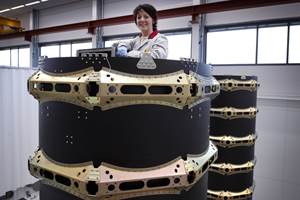JEC Europe 2013: And on the second day, the snow melted
A relatively rare European snowstorm brought much of the continent to a halt on the first day of the JEC Europe 2013 show. But the show went on . . .

The JEC Europe 2013 trade show, being held this week in Paris, got off to an auspicious beginning with a rare and dramatic snow storm on Day 1 that shut down much of Europe and kept some exhibitors and many attendees either at home, stuck in an airport or stranded at a train depot. All the same, enough composites professionals slogged through the ice and snow to make the first day successful, and sun on the second day banished much of the moisture. CW editors were among the attendees and offer some highlights.
In the Innovation Awards corner of the hall, the big attraction has been the award-winning carbon fiber passenger cell of the forthcoming all-electric BMW i3 car (see photo). Featuring SGL Group (Wiesbaden, Germany) carbon fiber produced in the U.S., and due on the market later this year, the i3 represents the first production vehicle to use carbon fiber in the passenger cell and deserved the attention it received. The question looming over the i3 has been what the body panels would be manufactured of. Official word is scarce, but injeciton molding machine maker ENGEL reports that it has sold two large machines to BMW for use in its Leipzig, Germany, facility "to manufacture lightweight components for car body shells." The car is not identified, but if one reads the tea leaves, and understands that the Leipzig plant is being used for primary asembly of the i3, then it's probably not unfair to assume that the i3 body panels will indeed be plastic.
Carbon fiber manufacturer Hexcel (Stamford, Conn., USA) held a press conference on Day 1 and reviewed the role its materials are playing on the Airbus A350 XWB, which is more than 50 percent composites by weight and expected to fly for the first this summer. Hexcel's HexPlay, HexTow and Acouti-Cap products are used variously in the A350's fuselage cockpit, fuselage, vertical tail and horizontal stabilizer, wing covers and spars, wing leading and trailing edges, center wing box, belling fairing and other parts. All told, said Hexcel officials, each A350 XWB represents $4 million in revenue from composite materials. Equally, if not more, interesting was Hexcel's introduction of HiTape UD, a dry carbon fiber for automatic placement applications and out-of-autoclave vacuum infusion processing. Hexcel says it's targing the material to aerostructures applications and exhibited on its stand a demonstration panel molded by Spirit AeroSystems (Wichita, Kan., USA) using the new HiTape UD product (see photo).
Radius Engineering (Salt Lake City, Utah, USA) got some attention on its stand for the 7m/23-ft carbon fiber multispar flap molded in one shot using the same qualified resin transfer molding (SQRTM) process, which provides autoclave-like consolidation outside of the autoclave. The flap, which Radius says is designed (but not necessarily destined for) an Airbus A320, is made with Cytec 977-2 prepreg and molded in a compression molding machine built by Radius. The tool features aluminum mandrels in the core. Additional pressure, per the SQRTM process, is provided also by resin injected around but not into the fabric by a Radius injection system.
JEC Europe wraps up on Thursday, March 14.
Related Content
Materials & Processes: Composites fibers and resins
Compared to legacy materials like steel, aluminum, iron and titanium, composites are still coming of age, and only just now are being better understood by design and manufacturing engineers. However, composites’ physical properties — combined with unbeatable light weight — make them undeniably attractive.
Read MoreMFFD thermoplastic floor beams — OOA consolidation for next-gen TPC aerostructures
GKN Fokker and Mikrosam develop AFP for the Multifunctional Fuselage Demonstrator’s floor beams and OOA consolidation of 6-meter spars for TPC rudders, elevators and tails.
Read MoreRUAG rebrands as Beyond Gravity, boosts CFRP satellite dispenser capacity
NEW smart factory in Linköping will double production and use sensors, data analytics for real-time quality control — CW talks with Holger Wentscher, Beyond Gravity’s head of launcher programs.
Read MoreOne-piece, one-shot, 17-meter wing spar for high-rate aircraft manufacture
GKN Aerospace has spent the last five years developing materials strategies and resin transfer molding (RTM) for an aircraft trailing edge wing spar for the Airbus Wing of Tomorrow program.
Read MoreRead Next
Composites end markets: Energy (2024)
Composites are used widely in oil/gas, wind and other renewable energy applications. Despite market challenges, growth potential and innovation for composites continue.
Read MoreCW’s 2024 Top Shops survey offers new approach to benchmarking
Respondents that complete the survey by April 30, 2024, have the chance to be recognized as an honoree.
Read MoreFrom the CW Archives: The tale of the thermoplastic cryotank
In 2006, guest columnist Bob Hartunian related the story of his efforts two decades prior, while at McDonnell Douglas, to develop a thermoplastic composite crytank for hydrogen storage. He learned a lot of lessons.
Read More

















.jpg;maxWidth=300;quality=90)








